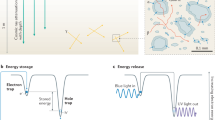Abstract
Quartz is the datable component in mortar. Although its luminescence properties are very well studied, the problem of mortar dating arises from a low level of optical bleaching. In order to reduce the time consuming efforts for dating lime mortar in monuments by optically stimulated luminescence, we investigated the most suitable methods of dose and dose rate determination, and we explored tests which are suitable to predict the datability of a given material. Reverting to the large number of publications on sedimentary partially bleached quartz we found linear modulation techniques especially useful, equally we also recommend the determination of the level of optical depletion before starting analyses. Single grain analysis is regarded as an ultimate but infallible tool to date very poorly bleached quartz from mortar. Dose rate measurements need to take into account the radioactive equilibrium of the uranium decay and the short range inhomogeneity of the environmental gamma radiation field: gamma spectrometry and on-site TLD measurements are best suited.
Similar content being viewed by others
References
Adamiec G and Aitken M, 1998. Dose-rate conversion factors: update. Ancient TL 16(2): 37–50.
Aitken MJ, 1998. An Introduction to Optical Dating. Oxford, Oxford University Press: 276 pp.
Agersnap Larsen N, Bulur E, Bøtter-Jensen L and McKeever SWS, 2000. Use of the LM-OSL technique for the detection of partial bleaching in quartz. Radiation Measurements 32(5–6): 419–425, DOI 10.1016/S1350-4487(00)00071-8.
Ankjærgaard C and Murray AS, 2007. Total beta and gamma dose rates in trapped charge dating based on beta counting. Radiation Measurements 42: 352–359, DOI 10.1016/j.radmeas.2006.12.007.
Bailey RM, Stokes S and Bray H, 2003. Inductively-coupled plasma mass spectrometry (ICP/MS) for dose rate determination: some guidelines for sample preparation and analysis. Ancient TL 21: 11–15.
Bailiff IK, 2007. Methodological developments in the luminescence dating of brick from English late-medieval and post-medieval buildings. Archaeometry 49: 827–851, DOI 10.1111/j.1475-4754.2007.00338.x.
Banerjee D, Murray AS, Bøtter-Jensen L and Lang A. 2001. Equivalent dose estimation using a single aliquot of polymineral fine grains. Radiation Measurements 33(1): 73–93, DOI 10.1016/S1350-4487(00)00101-3.
Bøtter-Jensen L, Solongo S, Murray AS, Banerjee D and Jungner H. 2000a. Using OSL single-aliquot regenerative-dose protocol with quartz extracted from building materials in retrospective dosimetry. Radiation Measurements 32(5–6): 841–845, DOI 10.1016/S1350-4487(00)00066-4.
Bøtter-Jensen L, Bulur E, Duller GAT and Murray AS, 2000b. Advances in luminescence instrument systems. Radiation Measurements 32(5–6): 523–538, DOI 10.1016/S1350-4487(00)00039-1.
Bulur E, Bøtter-Jensen L and Murray AS, 2000. Optically stimulated luminescence from quartz measured using the linear modulation technique. Radiation Measurements 32(5–6): 407–411, DOI 10.1016/S1350-4487(00)00115-3.
Degering D and Krbetschek MR, 2007. Dating of interglacial sediments by luminescence methods. In: Developments in Quarternary Science 7:157–172. Series editor: Jaap JM van der Meer. Elsevier.
Duller GAT, Bøtter-Jensen L and Murray AS, 2000. Optical dating of sand-sized quartz: sources of variability. Radiation Measurements 32(5–6): 453–457, DOI 10.1016/S1350-4487(00)00055-X.
El-Faramawy NA, Göksu HY and Panzer W, 2004. Thermoluminescence dosimetry properties of a new thin beta detector (LiF:Mg, Cu, P; Gr-200F) in comparison with highly sensitive Al2O3:C beta dosimeters. Journal of Radiological Protection 24: 273–282, DOI 10.1088/0952-4746/24/3/006.
Fleming SJ, 1979. Thermoluminescence Techniques in Archaeology. Oxford, Clarendon Press: 233 pp.
Galbraith RF, Roberts RG, Laslett GM, Yoshida H, Olley JM, 1999. Optical dating and multiple grains of quartz from Jinmium rock shelter, Northern Australia: part I experimental design and statistical models. Archaeometry 41(2): 339–364, DOI 10.1111/j.1475-4754.1999.tb00987.x.
Gilmore G, 2008. Practical Gamma-Ray Spectrometry. New York, John Wiley: 424 pp.
Goedicke C, 2003. Dating historical mortars by blue OSL: results from known age samples. Radiation Measurements 37: 409–415, DOI 10.1016/S1350-4487(03)00010-6.
Goedicke C, 2006. Assessment of environmental dose rates in luminescence readers using α-Al2O3:C. Radiation Measurements 41: 36–39, DOI 10.1016/j.radmeas.2005.02.006.
Goedicke C and Dolata J, 2007. Unpublished.
Göksu HY, Bulur E and Wahl W, 1999. Beta dosimetry using thin-layer α-Al2O3:C TL detectors. Radiation Protection Dosimetry 84(1–4): 451–455.
Hale J, Heinemeier J, Lancaster L, Lindross A and Ringbom Å, 2003. Dating ancient mortar. American Scientist: 91, 130 ff, DOI 10.1511/2003.2.130.
Jain M, Thomsen KJ, Bøtter-Jensen L, Murray AS, 2004. Thermal transfer and apparent-dose distributions in poorly bleached mortar samples: results from single grains and small aliquots of quartz. Radiation Measurements 38: 101–109, DOI 10.1016/j.radmeas.2003.07.002.
Jain M, Murray AS, Bøtter-Jensen L and Wintle AG, 2005. A single-aliquot regenerative-dose method based on IR (1.49 eV) bleaching of the fast component in quartz. Radiation Measurements 39: 309–318, DOI 10.1016/j.radmeas.2004.05.004.
Lindroos A, Heinemeier J, Ringbom Å, Braskén M and Sveinbjörnsdóttir Á, 2007. Mortar Dating Using AMS 14C and Sequential Dissolution: Examples from Medieval, Non-Hydraulic Lime Mortars from the Åland Islands, SW Finland. Radiocarbon 49: 47–67.
Martini M and Sibilia E, 2006. Absolute dating of historical buildings: the contribution of thermoluminescence (TL). Journal of Neutron Research 14: 69–74, DOI 0.1080/10238160600673326.
Murray AS and Wintle AG, 2000. Luminescence dating of quartz using an improved single-aliquot regenerative-dose protocol. Radiation Measurements 32(1): 57–73, DOI 10.1016/S1350-4487(99)00253-X.
Nawrocka D, Michiniewicz J, Pawlyta J and Pazdur A, 2005. Application of radiocarbon method for dating of lime mortars. Geochronometria 24: 109–115.
Preusser F and Kasper HU, 2001. Comparison of dose rate determination using high-resolution gamma spectroscopy and inductively coupled plasma-mass spectrometry. Ancient TL 19: 19–23.
Scharf A, 2007. Datenanalyse und Qualitätssicherung der 14C-AMSMessungen am Erlanger Tandembeschleuniger und Erweiterung des Sortiments 14C-datierbarer Probenmaterialien. Unpublished PhD thesis, Friedrich-Alexander University, Erlangen-Nürnberg.
Wintle AG and Murray AS, 2006. A review of quartz optically stimulated luminescence characteristics and their relevance in single-aliquot regeneration dating protocols. Radiation Measurements 41: 369–391, DOI 10.1016/j.radmeas.2005.11.001.
Zacharias N, Mauz B and Michael CT, 2002. Luminescence quartz dating of lime mortars. A first research approach. Radiation Protection Dosimetry 101: 379–382.
Author information
Authors and Affiliations
Corresponding author
About this article
Cite this article
Goedicke, C. Dating mortar by optically stimulated luminescence: A feasibility study. Geochron 38, 42–49 (2011). https://doi.org/10.2478/s13386-011-0002-0
Received:
Accepted:
Published:
Issue Date:
DOI: https://doi.org/10.2478/s13386-011-0002-0




